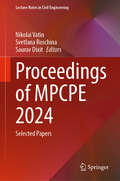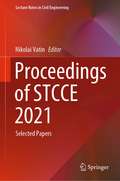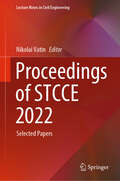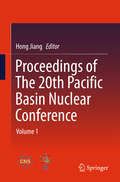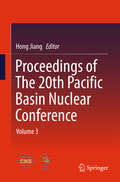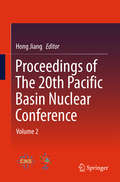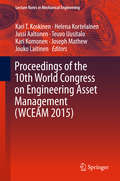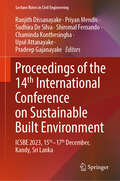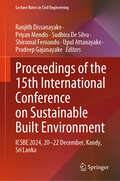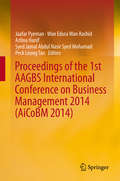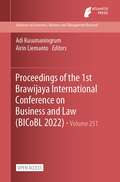- Table View
- List View
Proceedings of MPCPE 2024: Selected Papers (Lecture Notes in Civil Engineering #576)
by Nikolai Vatin Svetlana Roschina Saurav DixitThis book gathers selected contributions in the field of civil and structural engineering, as presented by international researchers and engineers at the International Conference on Materials Physics, Building Structures and Technologies in Construction, Industrial and Production Engineering (MPCPE), held in Vladimir, Russia, on April 22–25, 2024. The book covers a wide range of topics including the theory and design of capital construction facilities, engineering, and hydraulic structures; development of innovative solutions in the field of modeling and testing of reinforced concrete, metal, and wooden structures, as well as composite structures based on them; investigation of complex dynamic effects on construction objects, and many others directions. Intended for professional builders, designers, and researchers. The contributions, which were selected by means of a rigorous international peer-review process, highlight numerous exciting ideas that will spur novel research directions and foster multidisciplinary collaborations.
Proceedings of PURPLE MOUNTAIN FORUM 2019-International Forum on Smart Grid Protection and Control: Volume I (Lecture Notes in Electrical Engineering #584)
by Yusheng Xue Saifur Rahman Yuping ZhengThis book presents original, peer-reviewed research papers from the 4th Purple Mountain Forum –International Forum on Smart Grid Protection and Control (PMF2019-SGPC), held in Nanjing, China on August 17–18, 2019. Addressing the latest research hotspots in the power industry, such as renewable energy integration, flexible interconnection of large scale power grids, integrated energy system, and cyber physical power systems, the papers share the latest research findings and practical application examples of the new theories, methodologies and algorithms in these areas. As such book a valuable reference for researchers, engineers, and university students.
Proceedings of PURPLE MOUNTAIN FORUM 2019-International Forum on Smart Grid Protection and Control: Volume II (Lecture Notes in Electrical Engineering #585)
by Yusheng Xue Saifur Rahman Yuping ZhengThis book presents original, peer-reviewed research papers from the 4th Purple Mountain Forum –International Forum on Smart Grid Protection and Control (PMF2019-SGPC), held in Nanjing, China on August 17–18, 2019. Addressing the latest research hotspots in the power industry, such as renewable energy integration, flexible interconnection of large scale power grids, integrated energy system, and cyber physical power systems, the papers share the latest research findings and practical application examples of the new theories, methodologies and algorithms in these areas. As such book a valuable reference for researchers, engineers, and university students.
Proceedings of SECON’24: Structural Engineering and Construction Management (Lecture Notes in Civil Engineering #607)
by P. E. Kavitha S. Jawahar Saud Jiji Antony Moncef Nehdi Rahimi A. Rahman Robin P. DavisThis book gathers peer-reviewed contributions presented at the 5th International Conference on Structural Engineering and Construction Management (SECON’24), held in Angamaly, Kerala, India, on 5–7 June 2024. The meeting served as a fertile platform for discussion, sharing sound knowledge and introducing novel ideas on issues related to sustainable construction and design for the future. The respective contributions address various aspects of numerical modeling and simulation in structural engineering, structural dynamics and earthquake engineering, advanced analysis and design of foundations, BIM, building energy management, and technical project management. Accordingly, the book offers a valuable, up-to-date tool and essential overview of the subject for scientists and practitioners alike, and will inspire further investigations and research.
Proceedings of STCCE 2021: Selected Papers (Lecture Notes in Civil Engineering #169)
by Nikolai VatinThis book gathers selected contributions in the field of civil and construction engineering, as presented by international researchers and engineers at the 2nd International Scientific Conference on Socio-Technical Construction and Civil Engineering (STCCE), held in Kazan, Russia on April 21-28 2021. The book covers a wide range of topics including building constructions and structures, bridges, roads and tunnels, building materials and products, construction management, energy efficiency and thermal protection of buildings, ventilation, air conditioning, gas supply and lighting in buildings, innovative and smart technologies in construction, sustainable development, transport system development. The contributions, which were selected by means of a rigorous international peer-review process, highlight numerous exciting ideas that will spur novel research directions and foster multidisciplinary collaborations.
Proceedings of STCCE 2022: Selected Papers (Lecture Notes in Civil Engineering #291)
by Nikolai VatinThis book gathers selected contributions in the field of civil and construction engineering, as presented by international researchers and engineers at the 3rd International Scientific Conference on Socio-Technical Construction and Civil Engineering (STCCE), held in Kazan, Russia on April 21-29 2022. The book covers a wide range of topics including building constructions and structures, bridges, roads and tunnels, building materials and products, energy efficiency and thermal protection of buildings, ventilation, air conditioning, gas supply and lighting in buildings, innovative and smart technologies in construction, transport system development. The contributions, which were selected by means of a rigorous international peer-review process, highlight numerous exciting ideas that will spur novel research directions and foster multidisciplinary collaborations.
Proceedings of Selected Articles of 2013 World Agricultural Outlook Conference
by Shiwei XuFood security has always been a major global concern and is getting more attention in recent years. In fact, the global economy and stability has been severely challenged by the precarious state of food security, which was exacerbated by a combination of sharp price volatility and disastrous weather conditions related to climate change. The book aims to improve the analysis and projection of agricultural production and marketing, facilitates information exchange to better food supply and demand, and ultimately contributes to enhance world food security and sustainable global agricultural development.
Proceedings of The 20th Pacific Basin Nuclear Conference
by Hong JiangThis is the third in a series of three proceedings of the 20th Pacific Basin Nuclear Conference (PBNC). This volume covers the topics of Power Reactor and New Buildings, Waste Management, Acquiring Medical and Biological Benefits and Student program. As one in the most important and influential conference series of nuclear science and technology, the 20th PBNC was held in Beijing and the theme of this meeting was "Nuclear: Powering the Development of the Pacific Basin and the World". It brought together outstanding nuclear scientist and technical experts, senior industry executives, senior government officials and international energy organization leaders from all across the world. The book serves as a useful reference not only for the professionals and public to know more about nuclear industry, but also for policymakers to adjust or make energy strategies.
Proceedings of The 20th Pacific Basin Nuclear Conference
by Hong JiangThis is the third in a series of three proceedings of the 20th Pacific Basin Nuclear Conference (PBNC). This volume covers the topics of Power Reactor and New Buildings, Waste Management, Acquiring Medical and Biological Benefits and Student program. As one in the most important and influential conference series of nuclear science and technology, the 20th PBNC was held in Beijing and the theme of this meeting was "Nuclear: Powering the Development of the Pacific Basin and the World". It brought together outstanding nuclear scientist and technical experts, senior industry executives, senior government officials and international energy organization leaders from all across the world. The book serves as a useful reference not only for the professionals and public to know more about nuclear industry, but also for policymakers to adjust or make energy strategies.
Proceedings of The 20th Pacific Basin Nuclear Conference
by Hong JiangThis is the third in a series of three proceedings of the 20th Pacific Basin Nuclear Conference (PBNC). This volume covers the topics of Power Reactor and New Buildings, Waste Management, Acquiring Medical and Biological Benefits and Student program. As one in the most important and influential conference series of nuclear science and technology, the 20th PBNC was held in Beijing and the theme of this meeting was "Nuclear: Powering the Development of the Pacific Basin and the World". It brought together outstanding nuclear scientist and technical experts, senior industry executives, senior government officials and international energy organization leaders from all across the world. The book serves as a useful reference not only for the professionals and public to know more about nuclear industry, but also for policymakers to adjust or make energy strategies.
Proceedings of The Fourth International Technical Symposium on Deepwater Oil and Gas Engineering (Lecture Notes in Civil Engineering #246)
by Baojiang Sun Zhiyuan Wang Jinsheng Sun Litao Chen Meiping ChenThis book is a compilation of selected papers from the Fourth International Technical Symposium on Deepwater Oil and Gas Engineering & The Third International Youth Forum on Gas Hydrate, held in Qingdao, China in December 2021. The work focuses on the advancement of techniques for the deepwater oil and gas exploitation and natural gas hydrate exploitation. The book introduces new ideas for exploring deepwater oil and gas hydrate in a safe and efficient way. Advances of the natural gas hydrate pilot production in South China Sea, in oil and gas flow assurance and emerging technologies based on clathrate hydrate will be presented. It is a valuable resource for both practitioners and academics working in the field of deepwater oil and gas engineering.
Proceedings of the 10th International Conference on Business, Accounting, Finance and Economics (Advances in Economics, Business and Management Research #234)
by Fanyu Chen Keng Soon William Choo Voon Hsien Lee Chooi Yi WeiThis is an open access book. The Faculty of Business and Finance, Universiti Tunku Abdul Rahman (UTAR) is pleased to organize the 10th International Conference on Business, Accounting, Finance, and Economics (BAFE 2022) on 11th October 2022 in virtual mode via Microsoft Teams or Zoom platform. This conference aims to bring together researchers to present up-to-date works that contribute to new theoretical, methodological and empirical knowledge
Proceedings of the 10th International Conference on Energy Engineering and Environmental Engineering (Environmental Science and Engineering)
by Zuoyu Sun Prodip K. DasThis book contains the proceedings of the 10th International Conference on Energy Engineering and Environmental Engineering (ICEEEE2023) that was held on August 6-8 2023 in Singapore. ICEEEE2023 is organized by Beijing Jiaotong University and Newcastle University. This book provides an international forum for discussion and communication of energy and environmental engineering.It is expected to report the latest technological developments in the fields developed by academic researchers and industrial practitioners, with a focus on renewable energy technologies and systems, energy efficiency and conservation, environmental pollution and control, sustainable development, and green cities. The contents of this proceedings will be useful to researchers, professionals, and policymakers alike.
Proceedings of the 10th World Congress on Engineering Asset Management (WCEAM #2015)
by Joseph Mathew Teuvo Uusitalo Kari T. Koskinen Helena Kortelainen Jussi Aaltonen Kari Komonen Jouko LaitinenThis book comprisesrefereed papers from the 10th World Congress on Engineering Asset Management(WCEAM 2015), held in Tampere, Finland in September 2015. These proceedingsinclude a compilation of state-of-the-art papers covering a comprehensive rangeof subjects equally relevant to business managers and engineering professionalsalike. With a focus on various aspects of engineering asset management rangingfrom strategic level issues to detail-level machine health issues, these papersaddress both industry and public sector concerns and issues, as well as advancedacademic research. Proceedings of theWCEAM 2015 is an excellent reference and resource for asset managementpractitioners, researchers and academics, as well as undergraduate andpostgraduate students at tertiary institutions or in the industry.
Proceedings of the 11th International Conference on Production Research – Americas: ICPR Americas 2022
by Fernando Deschamps Edson Pinheiro de Lima Sérgio E. Gouvêa da Costa Marcelo G. TrentinThis book presents the proceedings of the conference and provides valuable insights into the issues facing Small and Medium Enterprises (SMEs), particularly in the areas of sustainable operations and digitalization. It comprises a series of papers presented at the conference, covering topics such as: challenges faced by SMEs in a post-pandemic era; digitalization and its impact on SMEs; sustainable operations in SMEs; international market performance improvement in SMEs; SMEs infrastructure and integration with research, development, and innovation institutions; and SMEs participation in business networks. The papers offer a unique perspective on the challenges and opportunities facing SMEs and provides practical solutions for those looking to help their organizations thrive in a rapidly changing business environment.
Proceedings of the 14th International Conference on Sustainable Built Environment: ICSBE 2023, 15th–17th December, Kandy, Sri Lanka (Lecture Notes in Civil Engineering #517)
by Ranjith Dissanayake Priyan Mendis Sudhira De Silva Shiromal Fernando Chaminda Konthesingha Pradeep Gajanayake Upul AttanayakeThis book highlights the latest knowledge and innovations in the fields of civil engineering and construction industry striving for a sustainable built environment. This book consists of high-quality innovative research findings selected from the proceedings of the 14th International Conference on Sustainable Built Environment (ICSBE 2023) under the themes of Sustainable construction, urban green infrastructure and planning, rainwater harvesting and water conservation, high-performance concrete, indoor environmental quality and indoor plants, wind and hydro-power energy, waste and wastewater management for enhanced sustainability, impacts of climate change, carbon footprint, global climate model and landscaping, material flows and industrial ecology, sustainable materials, etc.
Proceedings of the 15th International Conference on Sustainable Built Environment: ICSBE 2024, 20-22 December, Kandy, Sri Lanka (Lecture Notes in Civil Engineering #652)
by Ranjith Dissanayake Priyan Mendis Sudhira De Silva Shiromal Fernando Pradeep Gajanayake Upul AttanayakeThis book highlights the latest knowledge and innovations in the fields of civil engineering and construction industry striving for a sustainable built environment. This book consists of high-quality innovative research findings selected from the proceedings of the 15th International Conference on Sustainable Built Environment (ICSBE 2024) under the themes of sustainable construction, urban green infrastructure and planning, rainwater harvesting and water conservation, high-performance concrete, indoor environmental quality and indoor plants, wind and hydro-power energy, waste and wastewater management for enhanced sustainability, impacts of climate change, carbon footprint, global climate model and landscaping, material flows and industrial ecology, sustainable materials, etc
Proceedings of the 16th Asian Urbanization Conference; AUC2024; 11–13 January; Binh Duong Province–Ho Chi Minh City, Vietnam: Forging a Livable and Sustainable Urban Future (Advances in 21st Century Human Settlements)
by George M. Pomeroy Ha Thuc Vien Nguyen Ngoc HieuThis book highlights peer reviewed articles from the 2024 Asian Urbanization Conference hosted by the Vietnamese German University in Vietnam. It is estimated that Asia continues to be the fastest urbanizing continent in the next few decades with mounting challenges and ample opportunities. The 2024 conference proceedings presents issues and perspectives in both global and local agendas. Findings and discussions from the book would reflect not only our learning how Asian cities and regions are transforming, but also our efforts of &‘Forging a Livable and Sustainable Urban Future&’, globally.
Proceedings of the 17th International Symposium on Advancement of Construction Management and Real Estate
by Jian Zuo Jiayuan Wang Liang Zou Zhikun DingThe Chinese Research Institute of Construction Management (CRIOCM) in collaboration with Shenzhen University (SZU) proudly invites all academics, researchers and professionals to participate in the CRIOCM 2012, the 17th International Symposium on "Advancement of Construction Management and Real Estate." We will uphold and preserve the idea and tradition of pragmatism and innovation, to offer an excellent academic and communication platform for academics and professionals to exchange information on the latest developments in real estate and construction management.
Proceedings of the 18th Conference of the Associated Research Centers for the Urban Underground Space: ACUUS 2023; 1–4 November; Singapore (Lecture Notes in Civil Engineering #471)
by Wei Wu Xiaozhao Li Yingxin Zhou Chun Fai LeungThis book presents peer-reviewed articles from the 18th Conference of the Associated Research Centers for the Urban Underground Space (ACUUS 2023) held in Singapore from November 1 to 4, 2023. It highlights new opportunities and challenges in underground space use amid a re-focus on exploring and developing the underground space as a strategic resource and part of sustainable development. The new frontier presents unprecedented opportunities for simultaneously improving urban infrastructure, urban livability, and resilience. At the same time, special challenges exist in developing underground space—both from a human design perspective and in terms of complexity, 3D planning, system integration, technical, and life cycle costs. Equally important is the need to move from the creation of underground space as a haphazard, last resort solution to a well-planned, and integrated use of underground space that can serve the needs of society for future generations as well as our own. As the world emerges from the COVID-19 pandemic and is faced with the many challenges in climate resilience, the works presented in this book provide a timely opportunity and an excellent forum for engaging discussions and exchanges among planners, designers, engineers, researchers, and policy makers.
Proceedings of the 18th International Conference on Computing in Civil and Building Engineering: ICCCBE 2020 (Lecture Notes in Civil Engineering #98)
by Eduardo Toledo Santos Sergio ScheerThis book gathers the latest advances, innovations, and applications in the field of information technology in civil and building engineering, presented at the 18th International Conference on Computing in Civil and Building Engineering (ICCCBE), São Paulo, Brazil, August 18-20, 2020. It covers highly diverse topics such as BIM, construction information modeling, knowledge management, GIS, GPS, laser scanning, sensors, monitoring, VR/AR, computer-aided construction, product and process modeling, big data and IoT, cooperative design, mobile computing, simulation, structural health monitoring, computer-aided structural control and analysis, ICT in geotechnical engineering, computational mechanics, asset management, maintenance, urban planning, facility management, and smart cities. Written by leading researchers and engineers, and selected by means of a rigorous international peer-review process, the contributions highlight numerous exciting ideas that will spur novel research directions and foster multidisciplinary collaborations.
Proceedings of the 18th Symposium on Environmental Issues and Waste Management in Energy and Mineral Production: SWEMP 2018—Selected Works
by Raj Singhal Eleonora Widzyk-Capehart Asieh HekmatThe research papers presented in these proceedings volumes cover the latest developments and findings in the fields of mine health, safety, energy, waste management,reclamation and rehabilitation, mine closure and environmental protection.Authors from over 20 countries with backgrounds in chemistry, engineering, technology and management, and hailing from the government, industry and academia, have contributed to this book.The contents of this book will be of interest to scientists, engineers, consultants and government personnel who are responsible for the development and implementation of innovative approaches, techniques and technologies in the minerals industries. It will also benefit academic researchers, as it addresses the latest advances in fundamental research.
Proceedings of the 19th International Symposium on Management (Advances in Economics, Business and Management Research #660)
by Werner Ria Murhadi Dudi Anandya Noviaty Kresna Darmasetiawan Juliani Dyah Trisnawati Putu Anom Mahadwartha Elsye TandelilinThis is an open access book. The INSYMA 19 will be the first INSYMA to be held in a hybrid format; the offline event will be held in Bali, Indonesia. Bali is chosen as the location of the INSYMA because it is known as Indonesia’s most famous tourist destination, not only for domestic but also for foreign tourists. Both offline and online presenters are welcome to contribute to this year’s conference.This is an open access book.
Proceedings of the 1st AAGBS International Conference on Business Management 2014 (AiCoBM #2014)
by Jaafar Pyeman Wan Edura Wan Rashid Azlina Hanif Syed Jamal Abdul Nasir Syed Mohamad Peck Leong TanThe proceedings of the 1st AAGBS International Conference on Business Management 2014 (AiCoBM 2014), held in Penang, Malaysia, gathers 57 refereed papers. They cover areas relating to various aspects of business management and reflect the conference's three main themes (management and marketing, economics and finance, and entrepreneurship) and present original papers contributed by researchers, scholars, professionals and postgraduate students. They address a range of disciplines that encompass each of the main themes. Using basic and applied research findings together with case studies they provide valuable information on current research trends in business management, international business, marketing, economics, finance, Islamic finance and economics, and entrepreneurship.
Proceedings of the 1st Brawijaya International Conference on Business and Law (Advances in Economics, Business and Management Research #251)
by Adi Kusumaningrum Airin LiemantoThis is an open access book.The advancement of science is an important basic for the country’s development. It should be supported by the analysis which could provide solutions of various problems and phenomena happened in society. One of the problems amidst the problems around the world is how to resolve the economics and social problem as a result of the COVID-19 Pandemic. The complex problems due to pandemic are not merely believed to be bias if it is solved by a science so that it needs collaboration of other social sciences. Due to these issues of social science, we are conducting the 1st Brawijaya International Conference on Business and Law (BICoBL) 2022 on the 27th of October, 2022 in Bogor. The theme of the conference entitles “Collaboration of Business and Law After Pandemic to Enhance Sustainable Development”. We are looking forward to having you in our conference.
